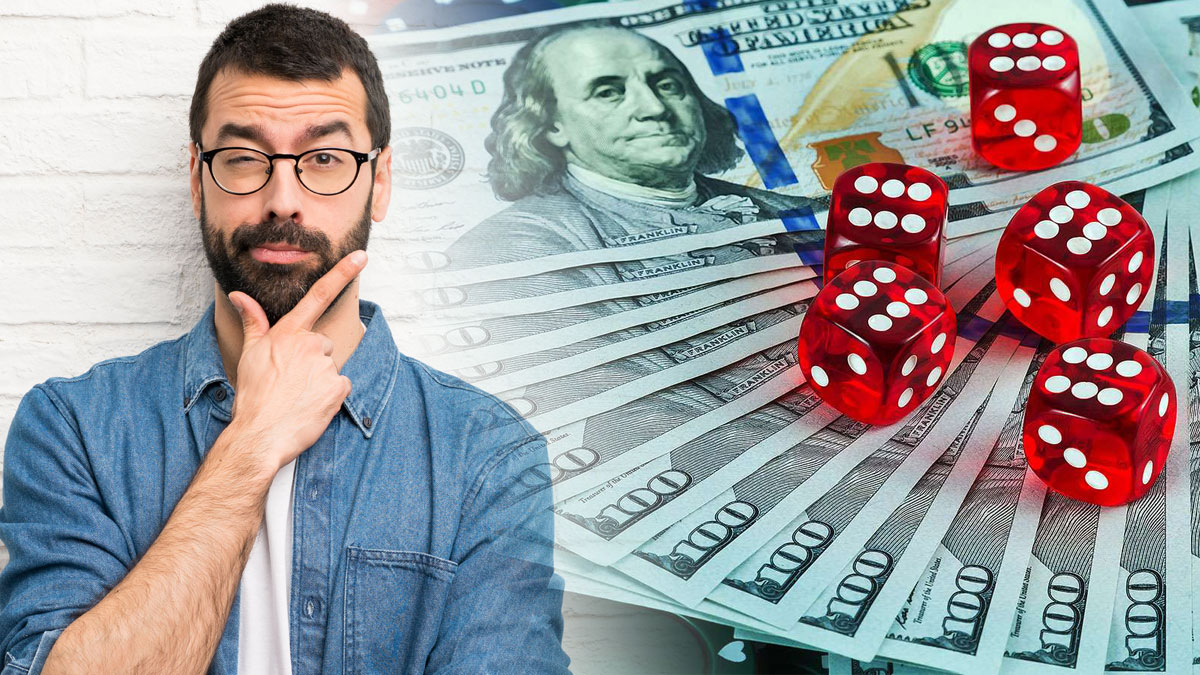Not all craps bets are made equal. Anytime you’re betting a large amount, you should place that wager on the bet where the house has the lowest advantage.
On this page, I’ll go over when you should and shouldn’t bet big on craps.
In some games, like roulette, the house edge is the same no matter which bet you make. Craps is the other kind of casino game; its the kind where different bets have a different advantage for the house.
If your goal is to make big bets in craps, you should stick with the following five bets, each of which I’ll describe in detail in this post:
- Pass
- Don’t pass
- Come
- Don’t come
- Odds
The house edge for the pass bet (and for the come bet) is 1.41%, making it one of the best bets at the craps table. The house edge for don’t pass (or don’t come) is 1.36%. This makes it a marginally better bet, but I don’t suggest it. You’ll have more fun rooting with the other gamblers at the table for the shooter to succeed. That’s worth 0.05%.
Finally, the odds bet is the bet you should put the most money on at the craps table. It’s one of only two bets I know of in a casino where the house edge is exactly 0%. (The other is the double-up feature on some video poker games.)
How the Pass Line and Come Bets Work
A game of in-house or online real money craps is played in rounds. A shooter rolls the dice for the first time with a come-out roll. If he “succeeds,” the pass line bet wins even money.
How does the shooter succeed?
The first is by succeeding on his initial roll. If he rolls a total of seven or 11 on his first roll, the pass line bet pays off immediately. If he rolls a two, three, or 12, he fails, and the pass line bet is forfeit.
If the shooter rolls any other number, the pass line bet stays in action. The other total that the shooter rolled becomes the point. To succeed in this event, the shooter must roll the point total again before rolling a seven. Any other totals are ignored for the purpose of resolving this bet.
If the shooter rolls a seven before rolling the point again, the pass line bet loses. This is the basic bet in craps.
The come bet is the same bet as the pass bet, but it treats a subsequent roll in a round as a new come-out roll. It wins under the same circumstances as the pass line bet.
It’s okay to bet big on either the pass line or the come bet.
Should You Bet Big on Don’t Pass and Don’t Come Bets?
The don’t pass bet is just a bet that the shooter will fail. It pays off on the come-out roll if the shooter rolls a two or three. It loses if the shooter rolls a seven or 11. It’s still an even money bet.
There’s one counterintuitive wrinkle to the don’t pass bet. If the pass bet loses when a 12 is rolled, you’d think that the don’t pass bet would win if a 12 is rolled on the come-out roll.
But that’s not the case. A 12 is treated as a push by the casino. This is so that the casino can maintain its house edge.
The don’t come bet, like the come bet, is also just a variation of the don’t pass bet. It just treats a subsequent roll as a new come-out roll.
Taking Odds Is the Real Opportunity to Bet Big
The rule of thumb is to bet the biggest on the bets with the lowest house edge. As we’ve already discussed, the best bets at the craps table have a house edge of 1.41%, 1.36%, and 0%.
Taking odds is the bet with the 0% house edge. It pays off at the same odds you have of winning, which means that there is no house edge at all.
You can only take odds on a pass line bet when the shooter has already made a point. The odds bet must at least be the same size as the pass line bet. It often has a limit to how much it can be, and that, too, is determined by the size of the pass line bet. It’s usually expressed as a multiple.
The higher the multiple, the more you can bet on the odds bet.
If the point is four or 10, the payoff is 2 to 1 on the odds bet. If the point is five or nine, the payoff is 3 to 2 on the odds bet. And if the point is six or eight, the payoff is 6 to 5 on the odds bet.
In most Vegas casinos, the amount you’re allowed to take on the odds bet is based on the point number. This is usually expressed as 3/4/5 odds. You’re allowed to bet 3X your pass bet if the point is four or 10, 4X your pass bet if the point is five or nine, and 5X your pass bet if the point is six or eight.
In some casinos, though, a flat multiple is made available. It might be as low as 1X the size of your pass bet. It would be unusual to see a casino offer 100X odds, but you can find several casinos that allow 10X and 20X odds.
This is where the real opportunity to bet big is.
Here’s an Example:
You bet $5 on the pass line, and you’re playing in a casino where you can take 10X odds. The shooter rolls a four, so you place the maximum odds bet of $50. (That’s 10 X $5.)
If the shooter wins, you get your $5 paid off at even money. Your $50 odds bet pays off at $100. (The payout is 2 to 1 on the odds bet when the point is a 4.)
This has the effect of reducing the house edge on all the money you have in action, which is exactly what your goal should be.
If you’re hoping to find the best craps bet to put big money on, it’s this one—the odds bet.
You have a good chance of getting an excellent return, and you’ll see a win fairly often. You’ll still lose this bet more often than not, but when you do win, you’ll get paid off. If you make this bet repeatedly, eventually, you’ll break even. Neither you nor the casino has an edge in this situation.
Laying the Odds Is Another Opportunity to Bet Big in Craps
Laying the odds is just the opposite of taking the odds. This is what you do when you start with the don’t pass bet. The payouts are reversed.
Another reason I recommend to new craps players that they stick with the pass line bet and take odds is because most gamblers don’t like to win payouts that are lower than their initial bet, even when the house edge is 0.
When you’ve bet the don’t pass line and lay odds, the payouts are again based on the point:
- If the point is four or 10, the payout is 1 to 2. If the point is five or nine, the payout is 2 to 3. And if the point is six or eight, the payout is 5 to 6.
- This means if you lay odds at $50 and win, you get a $25 payout. If that bet loses, you’re out $50.
- The house edge is still 0, but it’s just not as intuitive. It’s not, in my opinion, worth the extra 0.05% on the initial bet.
- You can also take and lay odds on come and don’t come bets, respectively. The payouts are the same. The only difference is which roll counts as the come-out roll for deciding the bet.
When Should You NOT Bet Big in Craps
Craps offers a wide variety of bets besides the ones I’ve described. I suggest to my readers that they should avoid all these bets. I prefer that the gamblers who read my posts stick with bets where the house edge is less than 1.5%.
But I also know that some readers like bets with bigger payouts, even if those bets carry with them a higher house edge.
To Those Readers, I Offer the Following Advice:
Only place small bets on the myriad of prop bets available at the craps table. And only make those bets with money you can afford to lose. The house edge on all those other bets is sky-high.
Conclusion
When should you bet big on craps? That’s easy. You should bet big on craps when you’re able to take or lay odds. This means that you’ve already placed a pass or don’t pass bet (or a come or don’t come bet).
It’s okay to put a lot of money on the initial bet, but it’s better to reserve as much money as possible and bet as much money as possible on the odds bet because the house edge is 0.
You’ll get a lot more action and entertainment for your money doing that than you will otherwise.
Michael Stevens
Michael Stevens has been researching and writing topics involving the gambling industry for well over a decade now and is considered an expert on all things casino and sports betting. Michael has been writing for GamblingSites.org since early 2016. …



